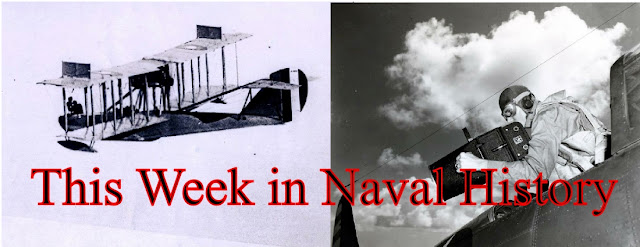 This Week in Naval History
This Week in Naval History4 Apr 1854: US & British navies engage Chinese troops at Shanghai
On 4 April 1854, American and British naval brigades of 90 and 150 men engaged Chinese Imperial troops at Shanghai after acts of aggression against American and British citizens. The Chinese fled after suffering many casualties. The American party under Cdr. J. Kelly, the Commanding Officer of USS Plymouth, had 2 men killed and 4 wounded. At the same time, a boat from Plymouth under Lt. J. Guest recaptured an American pilot boat from the midst of a fleet of Chinese craft.
5 Apr 1951: MOH-Hospitalman Richard De Wert, USNR
On 5 April 1951, during the Korean War, Hospitalman Richard De Wert served with the 2nd Battalion, 7th Marines in an attack on Chinese Communist forces. Wounded, De Wert persistently moved through fire-swept ground to aid fallen Marines. He was killed in action while administering first aid to an injured comrade. For his great heroism on this occasion, De Wert was posthumously awarded the Medal of Honor.
6 Apr 1917: US declared war on Germany
On 6 April 1917, following the sinking of U.S. merchant vessels by German U-boats, the U.S. declared war on Germany, entering World War I, which had started in Jul 1914 in Europe. Participating in escorting convoys, the US Navy faced the U-boat threat. In Europe, U.S. Army and Marines faced battles at Belleau Wood, Chateau Thierry, and St. Mihiel on the Western Front, while Naval and Marine Aviators faced the threat of the enemy in the air. On 11 Nov 1918, an armistice was signed with Germany near Compiegne, France, and the Peace Treaty was signed at Versailles, France, on 28 June 1919.
7 Apr 1776: Continental brig Lexington captured HMS Edward
On 7 April 1776, during the American Revolution, the Continental brig Lexington, commanded by John Barry, captured the British tender Edward, commanded by Lieutenant Boucher, near the Virginia Capes. To read more about Continental brig Lexington, please click here: http://www.history.navy.mil/danfs/l6/lexington-i.htm
8 Apr 1823: US Navy engaged pirates off Havana, Cuba
On 8 April 1823, the barges USS Mosquito and USS Gallinipper chased the pirate schooner, Pilot, off Havana, Cuba. Driving the vessel ashore, the ensuing battle resulted in two pirate fatalities and with one being captured. The other pirates escaped on shore where Marines landed to pursue them. The engagement was supported by sloop-of-war Peacock.
9 Apr 1943: Commodore rank was reestablished
On 9 April 1943, due to World War II, the rank of Commodore was reestablished as a temporary rank. Here are some images of Navy officers who held the rank of Commodore. After the war the flag rank structure reverted to its prewar form. By 1 January 1950, no commodores remained on active duty. When the Defense Officer Personnel Management Act (DOPMA) became law in 1982, O-7 officers were designated commodore admirals. The Navy selected 38 Captains to wear the broad stripe and single star. In 1983 the Defense Authorization bill changed the title to commodore. With President Reagan's signature on the Fiscal year 1986 Defense Authorization bill, O-7 officer were again called rear admiral (lower half).
10 Apr 1941: USS Niblack encountered German submarine
On 10 April 1941, as USS Niblack (DD 424) was nearing the Icelandic coast, the ship picked up three boatloads of survivors from Dutch freighter Saleier, sunk the previous day. When a submarine was detected preparing to attack, the division commander, Denis L. Ryan, ordered a depth charge attack which drove off the U-boat. This bloodless battle was the first action between American and German forces in World War II.
.jpg)





No comments:
Post a Comment